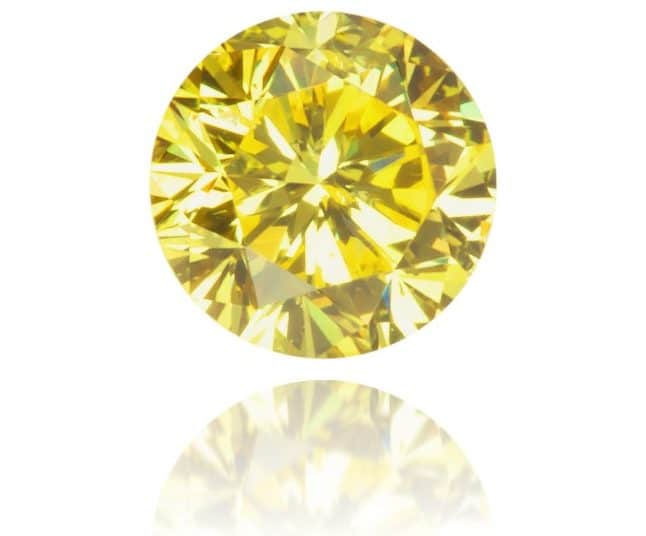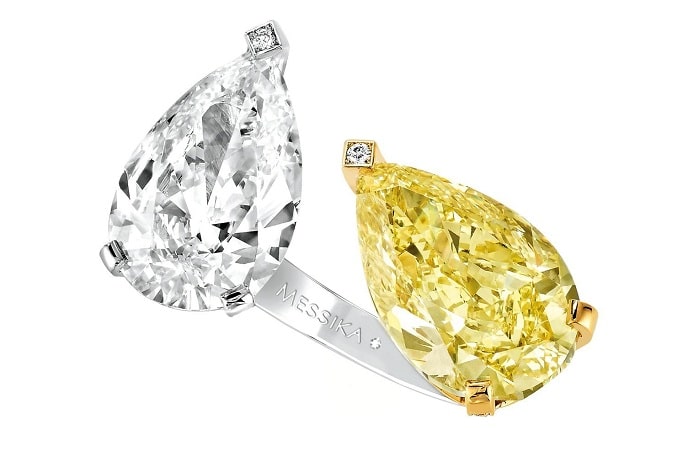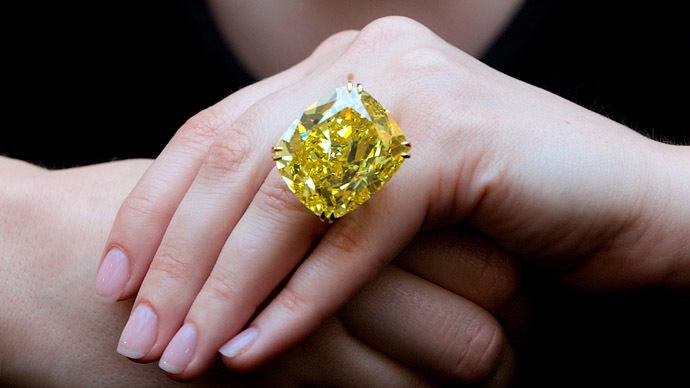Yellow diamonds are currently the most sought-after colored diamond in the world. But what gives yellow diamonds their color? And what are the biggest differences when you look at a yellow diamond vs white diamond? If you are one of millions of people who have questions about these types of diamonds, you’re in luck. Below, you will find all the information you need to know when considering yellow diamond vs white diamond options.
How Are Diamonds Made and How Do Yellow Diamonds Get Their Color?

No matter the color, all diamonds start out the same way. These structures are made of highly-organized carbon that have been heated at extreme temperatures, squeezed under immense pressure, and rushed to the planet’s surface to cool. This process could take millions of years, which is why many of today’s diamonds are manufactured in laboratories by two different methods.
Naturally colored diamonds, including yellow diamonds are formed virtually the same way, but with a slight variation. White (or clear) diamonds are completely pure and free of any particles during the crystallization-process. Yellow and other-colored diamonds are formed when foreign elements are trapped inside the structure during this crystallization-process. These particles change and alter the chemical process, changing the outcome.
Yellow diamonds and other-colored diamonds are rare and exceptionally beautiful. The specific color of the diamond is determined by which type of particle has affected the process. Yellow diamonds get their natural color when a specific grouping of nitrogen atoms enter the gem and assemble in a way that allows blue light to be absorbed; this reflects the yellow or canary hues you often see.
What Is the Difference between Yellow Diamonds and White Diamonds?

There is a lot of information out there in regards to diamond grading, scaling, and more. For white diamonds, a scale is used which ranges from D to Z. If the white diamond is graded at a D, that means that is as clear and pure as possible. If the white diamond is graded at a Z, that means that there is more tint to the diamond and more yellowish in tone. Prices tend to decrease as you go down the grading scale.
When you look at yellow diamonds, they are on a completely different scale. These are also known as fancy color diamonds. It is as if the yellow scale starts when the white-diamond scale ends. A diamond is considered yellow as it falls below a Z rating. The further it falls below this Z-rating, the more yellow tint the diamond contains. The color grading scale for yellow diamonds is as follows:
- Faint.
- Very light.
- Light.
- Fancy light.
- Fancy.
- Fancy intense.
- Fancy vivid, fancy deep, or fancy dark.
The largest difference when comparing a yellow diamond vs white diamond is simply how it is made. As stated above, yellow diamonds are created with the combination of particular nitrogen atoms. White, or clear diamonds are pure and free of any chemical impurities in its formation.
How Can You Tell the Difference between Naturally-Colored Diamonds and Treated Color Diamonds?
With today’s technology, it is no surprise that diamonds can be manufactured in the lab. Of course, it is more rare (and expensive) to have a naturally-colored diamond; but how can you tell the difference between the two? Lab-treated diamonds are cheaper because they are typically made from other less-expensive diamonds. It is fairly easy to spot the difference however, since the color of lab-treated yellow diamonds is so saturated that they may closely resemble semi-precious colored gems.
Does the Color of the Diamond Effect the Price?

Buying diamonds, especially when looking at yellow diamond vs white diamond, can be difficult. The color of the diamond is the most important factor in the price of a diamond. As you go down the scale for white diamonds, the prices increase as you head towards and D-rating and decrease as you head towards a Z-rating. However, once you go past that Z-rating and enter into a yellow classification, you should expect the prices to increase again. This is because if you are comparing a yellow diamond vs white diamond, yellow diamonds belong to a particularly special diamond-family.
This diamond-family is rare, which adds to the cost. It is estimated that only 1 out of every 10,000 diamond carats is a naturally-colored diamond. And out of those colors, an even smaller percentage is yellow. In regards to the pricing of yellow diamonds, the price can be determined by whether it is a pure yellow or a yellow diamond with secondary colors. If your yellow diamond has a rarer secondary color, the price will increase. If your yellow diamond contains a less rare secondary color, the price will go down.
What Other Factors Affect a Yellow Diamond’s Price?
One of the largest reasons for the expense of colored-diamonds can be answered by simple economics: supply and demand. Only an extremely small amount of the world’s diamonds are yellow-colored, so that allows jewelers and sellers a relatively-high profit margin. Since it is harder for the jeweler to receive these gems, they can charge you more for its rarity. Another problem in this market is the fact that the most sought-after diamonds are also the rarest. This allows sellers to charge purchasers more for their desire.
As with all colored-diamonds however, the yellow diamond’s cost is also determined by the carat (or weight of the diamond), cut, shape, clarity, and certification. Diamonds with high, geologist-graded certifications will obviously cost more than lower grades. The cut (or quality) of the diamond, as well as its shape are priced according mainly to rarity, with round-shaped diamonds costing much more than oval or cushion-shaped.
Summing Up
Diamonds are naturally- or man-made gems that truly represent the beauty in the world. Not only are yellow diamonds beautiful and rare, but they come with an air of sophistication and class. To find the ideal yellow diamond for you, remember to pay attention to color, clarity, cut, shape, and certification.






